[Network week2] IP Address, Classful Addressing, Subnetting, CIDR, DHCP, NAT
Computer Science
IP Address
- Concept of IP adress
- Classful and Classless
- Subnet and Supernet
IP Address Assignment
- The IP address space is managed by the Internet Assigned Numbers Authority (IANA) globally
- 5 regional Internet registries (RIR) are ARIN, LACNIC, RIPENCC, AFRINIC and APNIC
- Responsible for assignment to end users and local Internet service providers
Numbers
- The number of IP addresses in version 4
= Approximately 4.5 billion ( 2^32 ) - Subset of these have been distributed by IANA to the RIRs in blocks of approximately 16.8 million address each (*/8)
- Several new technologies have been adopted to mitigate an address shortage
: Classless Inter-Domain Routing (CIDR) in 1993
: Network address translation (NAT) in 1998
: A new version of the Internet Protocol, IPv6, in 1998
= Can support 3.4 x 10 ^ 38 adresses
= The only available long-term solution to IPv4 address exhaustion
Address Depletion
- IANA exhausted its IPv4 free pool on 3 January 2011
- IANA issued the LAST /8 address blocks equally to the five RIRs
- On 15 April 2011, APNIC reached the last /8
- RIPE depleted on 14 Sep.2012
- LACNIC depleted on Sep 2014
- ARIN is expected to exhaust in May 2015
Global Address
- Needs to be a way of identifying all the hosts (Global Uniqueness)
- Ethernet address are globally unique
: Flat structure
: Theoretically hierarchical - IP addresses are hierarchical
: Made up of several parts
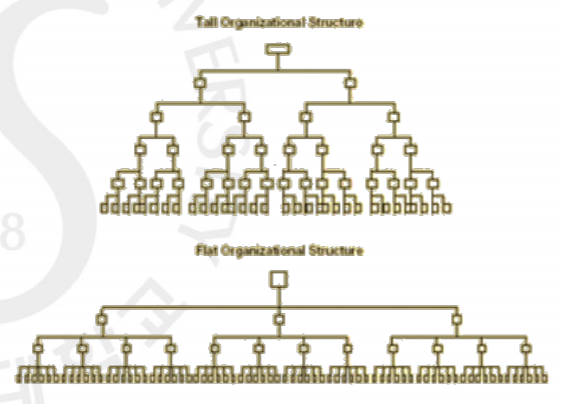
- Hierarchical Addressing
: It is unique
: It has hierarchy reading from bottom up or top down
: Quick to search
Area Routing Hierarchy
- A fixed-length AREA portion and an intra-area portion
: For instance, 8 bits for the area and 24 bits for the intra-area address - If a router sees a packet not in its own area
: It does a lookup on the "area" portion and forwards packets on - If a router sees a packet in its own area
: Just believer it toe destination - Usually hard to determine right size of "area" field
: Fixed length simply does not work
Address Structures in IP
- Topological Addressing
: Different from Ethernet addressing
: MAC address is location-independent
: Depends on its location in network topology - Can be aggregated in the routing table
Internet (IP) Address
- IP adress is a 32-bit binary address
: Unique and Universal
: 2^32 = 4,294,967,296 - Notation
- Binary
10000000 00001011 00000011 00011111 - Dotted-decimal
128.11.3.31
Classful Addressing
- In real deployment
- Five classes: Class A, B, C, D, and E
- A, B and C for unicast and D for multicast
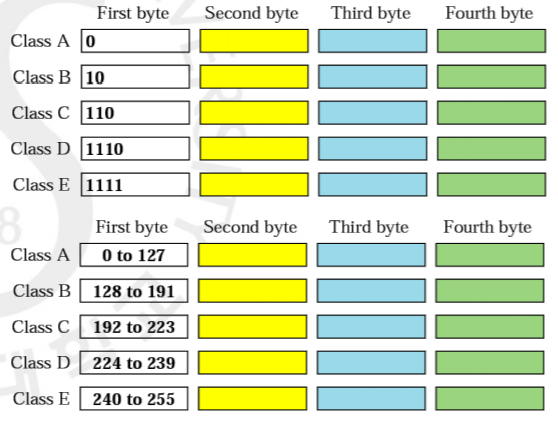
Net id and Host id
- 2-layer hierarchical
: Networks and hosts - Not applicable for class D and E

Network Address
- Hosts belonged to one network has the same network address
: Hosts in SKKU has the same network address - Representation
: NetID with all hostID bytes zeros - The first address in the block
- Cannot be assigned to host
Blocks in Class
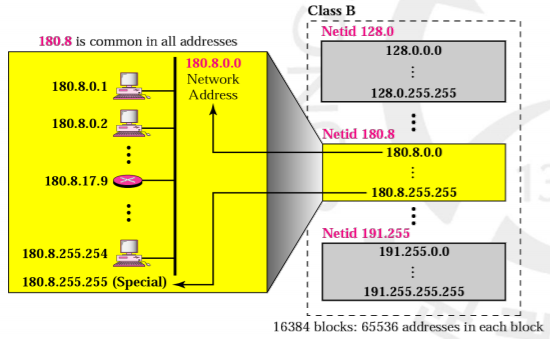
- How many hosts can be assigned in class A?
= 2^24 = 16 X 10^6, 16 million hosts - Millions of class A addresses are wasted
- Many class addresses are wasted
- In contrast, the number of addresses class C is smaller than needs
- Sample Internet (4 network)
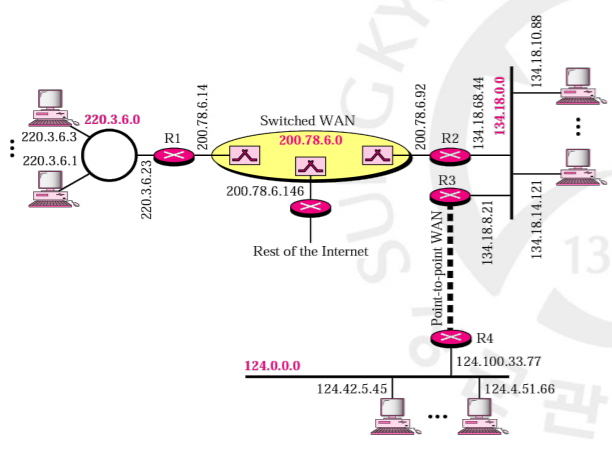
Hierarchy in addressing

- Network address is used by routers in the rest of Internet to route packets destined for network
- To reach host on Internet, we must first reach the network and then host
: 2-level hierarchy
Question
- How does a router find a network address?
: Network address can be found by applying the default mask to any address in the block - What is mask?
: A bit expression to represent the number of bits for network address

Example
- A router outside the organization receives a packet with destination address 190.240.7.91. Show how it finds the network address to route the packet
- The router follows three steps:
- The router looks at the first byte of the address to find the class. It is class B.
- The default mask for class B is 255.255.0.0. The router ANDs this mask with the address to get 190.240.0.0.
- The router looks in its routing table to find out how to route this packet to this destination
Subnetting
- One network divided into several subnetworks
: SKKU has two campuses and two subnetworks in Seoul and in Suwon - Outside knows network address
: Subnetwork address is recognized inside
: Three levels of hierarchy (Network, Subnet, Host)
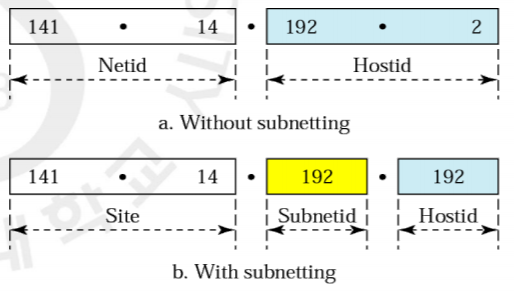
Question
- How does a router find a subnetwork address?
: Subnet mask
: Routers outside use a default mask
: Routers inside use a subnet mask - The number of subnets is determined by the number of extra 1s.
: If the number of extra 1s is n, the number of subnets is 2^n

Example
- A router inside the organization receives the same packet with destination address 190.240.33.91
- Show how it finds the subnetwork address to route the packet
- The router follows three steps:
- The router must know subnet mask
ex. Assume it is /19 - The router applies the mask to the address 190.240.33.91
: The subnet address is 190.240.32.0. - The router looks in its routing table to fine how to route the packet to this destination
- How does a router find a subnet mask?
: Network administrator must specify
< CIDR >
Allocation Problem
- Exhastion of the class B network address space
: Not 2^32 addresses but the number of network classes - Lack of a network class of size which is appropriate for mid-sizes organizaiton
: Class C, with maximum 254 hosts, too small
: While class B, with maximum 65534 hosts, too large - Allocate blck of class C instead
: We still need more network classes
: Issue multiple block class C addresses by spliting class B address into multiple class addresses
: How many class C addresses we have in the classful address?
: How many class C addresses in the single class B address?
HOW TO SOLVE
- Topologically allocate IP address assignment
- Divide the world into 8 regions allocate multiple class C blocks
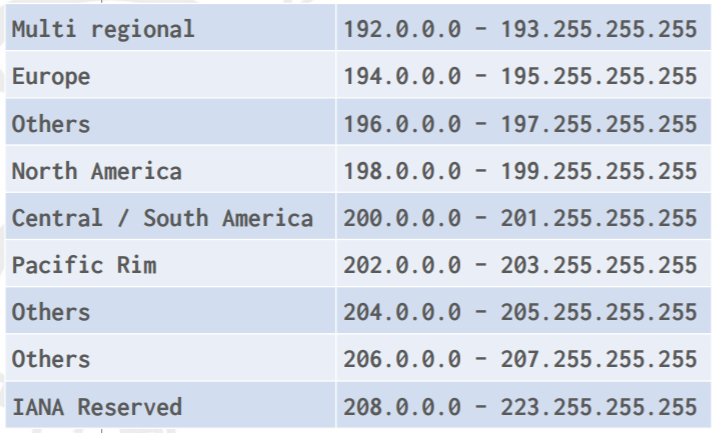
CIDR
- New class C address assignment becomes meaningless becasue it introduces problem of a large routing table
: By default, a routing table contains an entry for every network - Technique called Classless Interdomain Routing is introduced
: CIDR or Supernet - Key concept is to allocate multiple classes of addresses in the way that allow summarization into a smaller number of routing table
: Route aggregation - CIDR is based on route aggregation
: For instance, 16 class C addresses can be summarized to a single routing entry
Subnetting VS Supernetting
- Subnetting
: A network address block is divided into several subnetwork blocks - Supernetting
: Combine several class C blocks into a larger block
: Attractive to organizations that need more than 256 addresses
Supernetting
-
An organization is allocated a block of class C address in 2^n with a bitwise contiguous address space
: Achieved by using bits which belongs to the network address as hosts bits
: Alter the default class C subnet mask such that some bit change from 1 to 0 -
Supernetting example
: 4 class C networks appear to network outside as a single network
11111111 11111111 111111111 00000000 (Default class C mask)
11111111 11111111 111111100 00000000 (255.255.252.0)
Supernetting sample
- An organization with 4 class C

- After Supernetting

- Changed from 4 networks to a single network with 1,022 hosts
Classless Addressing
- Variable length of network address instead of fixed 8, 16, 24
- The total number of 1000 hosts
: 22 bit of network address is sufficient
: 255.255.252.0 => 256 X 2^2 = 1024 - ISP granted class B blocks can subdivide block of address to sell
: The number of blocks needs to be a power of 2 - How to specify variable network address?
: Use subnet mask - Given the first address and subnet mask
: 255.255.255.192 (mask) and 203.255.252.128 (first)
=> 203.255.252.128/26 (CIDR notation)
Example
- A classless address is given as 167.199.170.82/27
- The first address can be found by keeping the first 27 bits and changing the rest of bits to 0s.
- In classful address this address is belonged to class B
- The number of addresses in the network is 2^(32-27) = 2^5 = 32
: Address
167.199.170.82/27
10100111 11000111 10101010 01010010
: First Address
167.199.170.64/27
10100111 11000111 10101010 01000000
: Last Address
167.199.170.95/27
10100111 11000111 10101010 01011111
Example2
- An organization is granted a block of addresses with the beginning address 14.24.74.0/24
- The organization needs to have 3 subblocks of addresses to use its three subnets
: One subblock of 10 addresses
: One subblock of 60 addresses, and
: One subblock of 120 addresses
The first address is 14.24.74.0/24, the last address is 14.24.74.255/24 and 254 addresses

(14.24.74.192/28 *)
Special Addresses
-
This-host address
: 0.0.0.0/32
: Send an IP datagram but not knowing its own address to use as source -
Limited-broadcast address
: 255.255.255.255/32
: A router or a host needs to send a packet to all host in a network
: Packets cannot travel outside network -
Private address
: 10.0.0.0/8, 172.16.0.0/12, 192.168.0.0/16
and 169.254.0.0/16 -
Loopback
: 127.0.0.0/8
: Packets with one of these addresses in this block as destination never leaves the host -
Multicast
: 224.0.0.0/4 is reserved for multicast address
Solutions to Depletion
1. Long term solution is IPv6
2. CIDR(Classress Interdomain Routing) is a possible short term solution
3. DHCP and NAT are another short term solutions
DHCP
- Temporary, on demand, IP addresses assignments to hosts
: A traveler in the hotel
: ISP with 1000 granted address to service 4000 customers - Done automatically using Dynamic Host Configuration Protocol
: Application-layer program
: A client-server paradigm
: Plug-and-play protocol - DHCP assumes that not more than 1/4 customers use the Internet at the same time
NAT
- Network Address Translation
- 4000 hosts in company want to access the Internet simultaneously
: Use 4000 address from the private block addresses for internal communication
: 1000 addresses for global communication - NAT implements a mapping between private and global addresses
: 172.16.3.1/24 to 200.24.5.8 and vice versa
: A router function
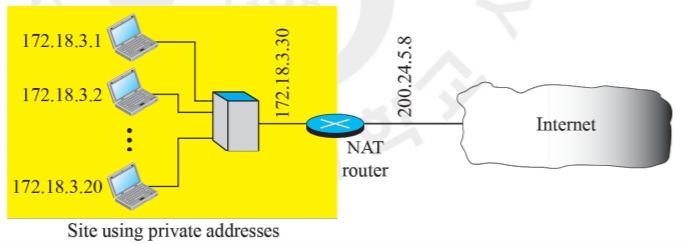
Address Translation
- Outgoing packets
: The NAT router replaces SRC address with the global NAT address - Incoming packets
: The NAT router replaces DST address with private address
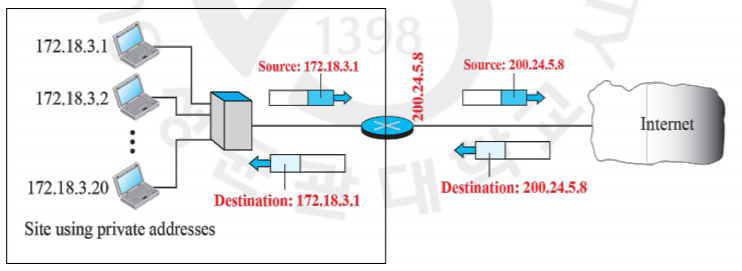
Translation Table
- 172.18.3.1 to 25.8.2.10 (DST)
- Straightforward to translate SRC for outgoing packets
- How does the NAT know DST for incoming packets?
: Translation table - 3 situations depending on the number of global IP addresses
: Single global IP address ( One private-network host to access a given external host)
: Pool of global IP addresses
: Both IP addresses and port addresses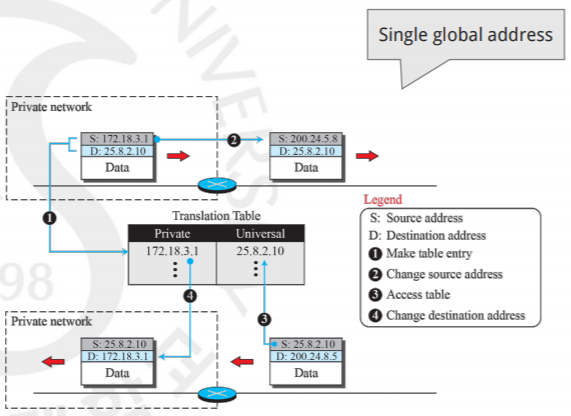
Pool of IP address
- In case of four global IP addresses
- 4 private-network hosts can communicate with the same external host at the same time
: one-to-many is okay
: No more than 4 connection made to the same destination - No private-network host can access 2 external hosts at the same time
: Many-to-one is NOT okay
IP addresses and Pool addresses
- Using TCP/UDP port number
: Ephemeral port address must be unique in host - Many-to-many relationship
- 5-column translation table
- For incoming packet
: 25.8.3.2 and 1401 defines private-network host

